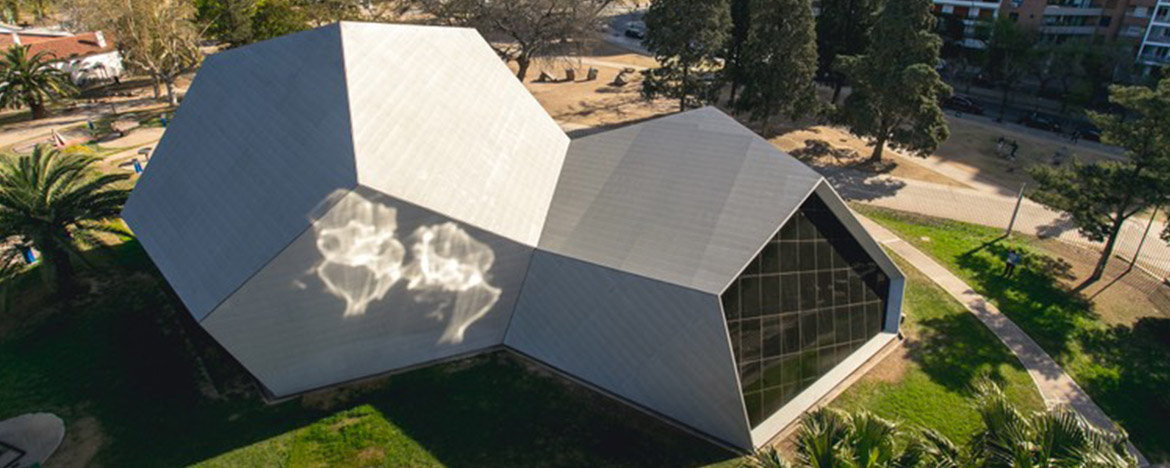The Plaza Cielo y Tierra Interpretive Center opens its doors
The Plaza Cielo y Tierra Interpretive Center opens its doors

It is an initiative promoted by Universidad Nacional de Córdoba together with the Province of Córdoba’s Government. With a bold architecture that imitates two dodecahedrons emerging to the surface, this center will be the privileged stage for countless activities focused on learning about our planet and the universe. Also, for getting to know more about science and its history. It is located at the Parque de las Tejas, at the entry of the university campus. It will be open for visitors from Wednesday to Sunday. [06.01.2018]
Today, the Plaza Cielo y Tierra Interpretive Center (Sky and Earth Square) will be open its doorsat the Parque de las Tejas –a preferential and strategic area in the city where thousands of students and passers-by walk daily. It is the first of its kind in the center of the country and is the outcome of the joint work between Universidad Nacional de Córdoba (UNC) and of the Province of Córdoba’s Government .
This new space will provide the perfect framework for countless educational and scientific activities to learn in an inventive way. Amusement, amazement and exploration will be the spirit of the guided tours where children and adults will learn more about the four fundamental elements –wind, earth, fire and water–, and how they intervene in the phenomena that occur in our planet and in the skies.
In order to achieve this, the Center has a planetarium, a screening room, a garden with footprints of prehistoric animals, a park with Cordobese rocks and a 52-foot-tall tower with a dome to practice astronomical observations with an 11-inch telescope.
It also has a combination of wit games with ropes, spheres, metal rings, pulleys and levers. The bravest can even take a chance on board of an outdoor gyroscope.
The main area of the Square is a cubist building with geometric shapes. On the inside, it has different sub-levels with one peculiarity: from any of these levels it is possible to see all the others. This is a very meaningful visual effect, accomplished with the use of translucent materials on the floors.
 Its outdoor architecture represents two dodecahedrons –figures with twelve pentagonal faces– emerging from within the planet´s interior. The dodecahedron is one of the five types of regular polyhedrons that constitute the “Platonic solids”. These had a strong symbolic meaning in the history of science, in particular, of astronomy.
Its outdoor architecture represents two dodecahedrons –figures with twelve pentagonal faces– emerging from within the planet´s interior. The dodecahedron is one of the five types of regular polyhedrons that constitute the “Platonic solids”. These had a strong symbolic meaning in the history of science, in particular, of astronomy.
Guillermo Goldes, who will be Scientific Secretary of the Center, explains: “Kepler thought that the planetary orbits were inserted inside large bodies such as the dodecahedrons. He believed that the dodecahedron represented the entire universe”.
Unlike museums, interpretive centers do not harbor patrimonial objects. Moreover, in the Sky and Earth Square, it was decided not to show interactive technology or large HD screens. “We don’t want people to get distracted”, said Mr. Goldes.
It is expected that the number of visitors will not exceed 80 per day –including school groups or groups from other institutions and the general public– so that they can make the most of their visit.
The Sky and Earth Square will open from Wednesday through Friday, from 9 a.m. to 7 p.m., and Saturday and Sunday, from 1:30 p. m. to 7 p.m. Entry passes have to be previously reserved via Internet. There will be 34 people working at the hall between guides and coordinators.
Formally, the Interpretive Center is going to be registered as a Foundation constituted by UNC and the provincial government. The president is going to be Daniel Barraco, professor, researcher and former dean of the Faculty of Mathematics, Astronomy, Physics and Computer Science (FaMAF) of the UNC.
Facebook: www.facebook.com/cieloytierra.centro.de.ciencias
e-mail: info@plazacielotierra.org
Phone: +54 351 433-3419 / 3424
Originally published at http://www.unciencia.unc.edu.ar/2017/septiembre/plaza-cielo-y-tierra on 09.11.2017
Translation: Marina Carrasco Fenoy



